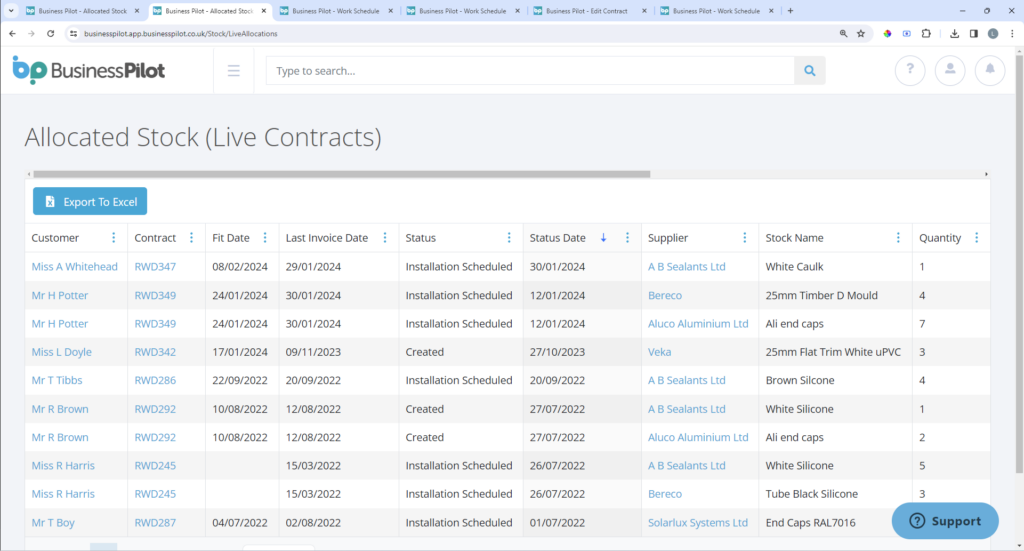Are you making the most of the Business Pilot Stock feature?
Lots of users are seeing the benefits of utilising the Stock area of our business management system and here’s why…
Benefits of ‘keeping stock’ with Business Pilot
- Simple, easy-to-use stock allocation system
- Allocate stock to jobs to keep track of job costs
- Store supplier details
- Manage stock orders and deliveries
- Monitor stock levels
- Set minimum stock levels to get alerts when stock is low
- Clear view of what stock is available and what’s already allocated to a job
- Assign a location to stock for easier stores management
How monitoring stock items helps your business…
No more ‘nipping to Screwfix’ or your local trade counter for fitting accessories, consumables and other installation essentials! Utilising our stock management feature means you can be confident that your fitting team has access to everything they need for the job, when they need it.
Having a tool that helps to keep a close eye on stock-levels, and record where stock has been allocated, could also save you expanding your warehouse facilities, by helping you to implement a ‘just-in-time’ stock management process.
Which items should I manage through the stock system?
Technically, you can add anything you like into your stock management system, but we always recommend using it for common items and consumables, such as silicone, screws and trims.
Bespoke items that are ordered specifically for a project, such as windows, doors, conservatory roofs, etc. should be managed through the Purchase Order system.
When you add an item into the stock area, there’s a ‘free type’ box when you add items, so you can add as much detail as you like. For example, you may go for something as simple as ‘White silicone’ or you may want to add extra detail, such as – ‘Soudal Silirub Silicone – Brilliant White’.
Managing stock
When you add stock to Business Pilot, you can record all the details you need to help you manage stock more efficiently:
- Supplier – supplier details are stored in the system so you can choose the supplier from a dropdown menu rather than inputting details every time
- Nominal Code – to link the spend with your accounting system
- Product Code – use your supplier’s product code, or one you use internally if that’s better for you
- Name – name of your stock item
- Location – assign a stock location to help your team find things faster
- Current Stock Level – how many items you currently have
- Current Stock Value – the value of the items you already have in your warehouse
- Minimum Stock Level – the lowest number of the item you want to have in stock – if this item is reached, a notification is sent to the ‘Stock Level Low Email’ address which you can set in the Admin area
- Target Restocking Level – the target level your stock should be at
- Current Item Price – what you’re currently paying for the item
- Toggle Stock Item as Active or Inactive – a toggle for making the item inactive/active – this is great if you’re changing brands and want to deplete stock levels of an old product, or if you’re trying something new and want that to be used first.
From the Manage Stock area, you can easily ‘restock’ items by adding a stock order to an item. Doing it this way means a lot of the information is already populated and ensures consistency for products names, product codes, nominal codes, etc.
Allocating stock
Once your stock is in the system it can be allocated to a contract in the allocate stock window. You can assign different stock products to different contracts within one window if you need to!
At any time, you can see what stock has been allocated in the Allocated Stock screens. One shows stock that’s allocated to Live Contracts and the other allocated stock for all contracts.
What happens if there isn’t enough stock?
If more items are required than you have in stock, the stock allocation will be sent for query.
You can choose which email address these stock queries go to. It may be your stores manager or just the person who deals with ordered stock items. There’s also a Stock Allocation Queries grid in the system if anyone else needs to check any queries.
Related reporting
Managing stock through Business Pilot helps you to monitor job costs and keep an eye on the price of your stock items over time.
You can run stock valuation reports at any time, which can be exported as a PDF or Excel file.
Want to learn more about utilising the Stock area in your business? Talk to Kerry about extra training, or chat to our Support team on 0333 050 7632.


